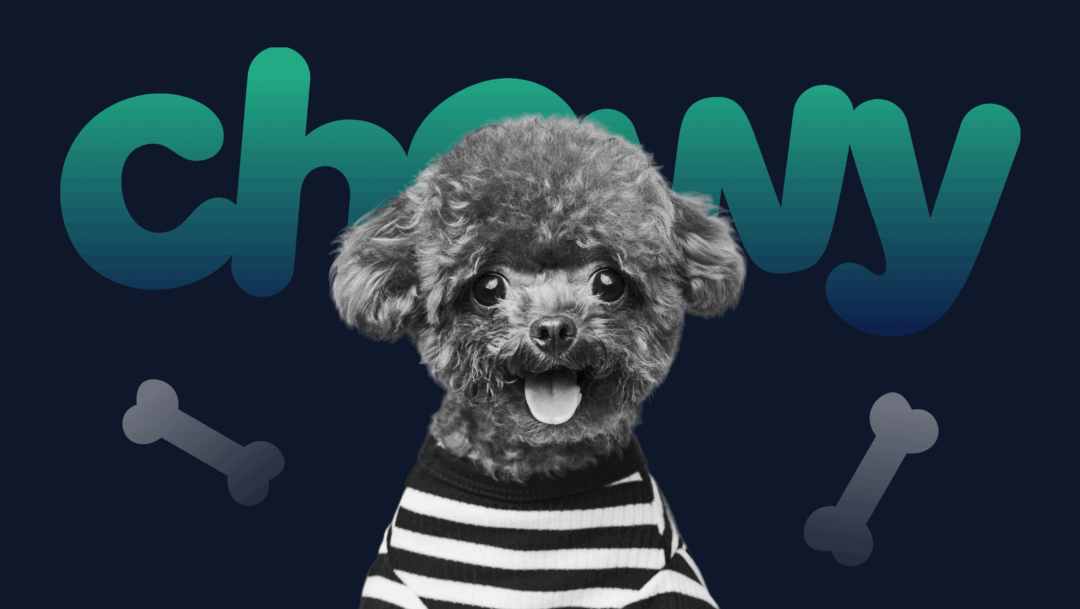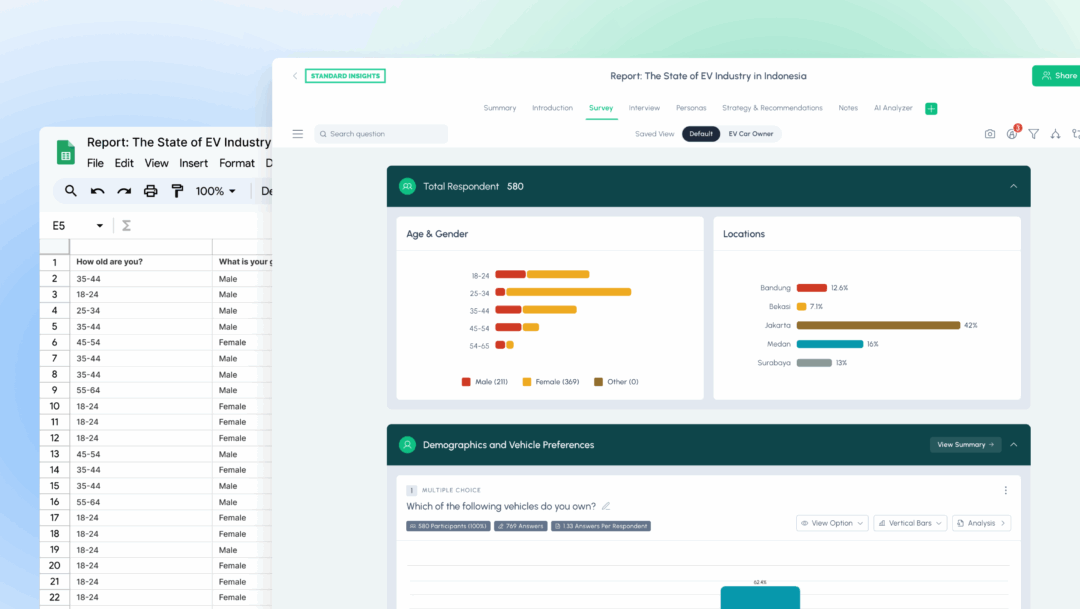How far would you go for a brand?
- Apple fans camp outside stores for new releases.
- IKEA enthusiasts have sleepovers in-store.
- Some people tattoo Harley-Davidson, Heinz, or even more recently, SEMrush logos on themselves.
But what about your customers?
Many believe loyalty is just about satisfaction—but it’s much more. Loyalty is built on emotional bonds.
Think of making a new acquaintance versus building a lifelong friendship. Loyalty is the “best friend” stage of customer relationships—it takes time, care, and more than just pleasant encounters.
So, what does true brand loyalty look like? How do you create it, measure it, and—if you’re doing it right—become the “best friend” your customers never want to lose?
Here’s how to build it, measure it, and get inspired by brands who’ve nailed it.
What Is Brand Loyalty?
Brand loyalty is when your customers choose you again and again—even if your competitors are cheaper, closer, or shouting louder.
It’s not about a lack of choices. It’s about a real, emotional preference.
Loyalty goes way beyond habit or convenience. It’s when customers miss your brand or feel a genuine sense of loss if you were suddenly gone. These are the people who not only come back—they promote you to others, defend you in group chats, and refuse to jump ship, even when tempted.
So, how do you spark that kind of connection?
Let’s break down the core characteristics that define true brand loyalty:
The 5 Characteristics of Brand Loyalty

1. Emotional Connection
Loyalty starts—and sticks—with emotion. Without it, what you’ve got is just a habit at best (or, worse, a passing fling). Habits are fragile; emotions stick.
Here’s the thing: emotional connection isn’t an accident. It’s built on two pillars:
- Brand feeling: The colors, fonts, mascots, and slogans that trigger instant recognition—think of the cues that set your vibe.
- Brand communication and action: How you talk, how you show up, your customer service, campaigns, and, most importantly, the human touches.
It’s the barista who remembers your name. The extra smile. The sense that you belong. That’s when a brand stops being just a logo and starts feeling like “home.”
Think DoubleTree by Hilton hotels: they’re famous for their warm welcome—which always comes with a complimentary chocolate chip cookie at check-in. Simple, right? But that little gesture leaves a lasting impression, turning a generic hotel stay into something personal and memorable. It’s the kind of thing guests share online and tell their friends about—a bonus burst of free word of mouth. – That’s emotional connection in action.

If your brand feels interchangeable, you haven’t built a real emotional connection yet. Focus on consistently sparking positive feelings and memories at every touchpoint. That’s where loyalty lives.
2. Resistance to Competition
Loyalty should make even considering a competitor feel wrong—sometimes even a little painful.
Customers who trust you stick around, even when a competitor’s cheaper, newer, or closer. They forgive mistakes, wait through backorders, and defend your brand in public.
Take Oatly oat milk: in 2024, when shelves ran dry, true Oatly fans didn’t just grab any old plant milk—they hunted for Oatly, visiting multiple stores or waiting for it to return. They’re loyal to the quirky brand identity and authentic values, not just the product.
When you consistently deliver on your promises and connect with what your customers care about, you build a loyalty that makes switching feel like betrayal. That’s how you protect your brand—even when you’re not perfect.
3. Positive Word-of-Mouth
Brand loyalty is contagious. When customers are truly loyal, they become advocates—spreading positive stories both online and offline.
What does this look like?
- Social media shout-outs and organic posts
- Genuine, enthusiastic product reviews
- User-generated content
- Personal recommendations and referrals
Why do they do it? Because something about your brand resonates—your story, your vibe, your values, or even just the status and satisfaction they feel. It clicks, and they want to share it.
If customers aren’t recommending you, their loyalty might be superficial or convenience-based—a risk for your brand’s long-term health.
4. Repeat Purchases
Repeat purchases are a clear behavioral indicator of loyalty. But beware: habit alone isn’t loyalty.
Customers return because each interaction reinforces trust, reliability, and emotional satisfaction—turning habit into intentional preference.
Over time, this routine becomes part of their identity. They see your brand as a dependable partner, not just a transaction.
5. Tolerance for Price Changes
A price increase will always drive some customers away—but for your loyalists, it’s not the deciding factor as long as you keep delivering.
Price sensitivity drops fast when real loyalty kicks in. It’s not that loyal customers don’t see prices—they just value the connection more than the cost.
Deliver consistent value and emotional satisfaction, and price tags fade into the background. At that point, your customers aren’t just buying a product—they’re investing in a relationship, a set of values, or even a sense of belonging.
In reality, there are more characteristics—like community, trust, commitment, and experience—but these five are the foundation. And it all starts with genuinely delivering value.
You can’t cherry-pick which characteristic to focus on. True brand loyalty only happens when you’re strong in all five areas. Skip one, and the whole foundation weakens—giving you fake signals and fragile loyalty.
So, how do you strengthen these foundations? Here’s how to get started:
How to Build Brand Loyalty (with Examples and Tips)
Building true brand loyalty goes beyond just a great product. It’s about exceeding expectations and creating emotional connections at every touchpoint. Here’s how leading brands do it:
1. Create a Clear, Memorable Brand Identity
Your brand shouldn’t just be recognized—it should be felt.
It’s not only about big causes like “saving the planet”—it’s about cultivating a personality and purpose that people actually connect with. Every element, from your logo and colors to your tone of voice and brand story, should reinforce this identity.
Example:
Duolingo’s owl isn’t just a mascot—it’s a cultural icon. When the company “killed off” the owl as an April Fools’ prank, users panicked. Why? Because the brand’s personality was so strong, people felt genuinely attached.
Actionable Tip:
Regularly audit your brand touchpoints. Does everything—from your social posts to your packaging—express your values and personality? If not, find ways to better align them.
Too many brands blend in by following the crowd instead of carving out their own space. Brand association is a powerful way to stand out. Take Hoist Hydration: instead of copying classic sports drinks like Powerade and Gatorade, Hoist leans into military associations in its branding, giving it a bold edge and a loyal community.
Want to see how it works in action? How Hoist Nails Brand Association
2. Overdeliver on Customer Service
Customer experience drives loyalty—big time. McKinsey found that companies that excel in customer experience grow revenue twice as fast as competitors.
But as we said, loyalty is like your best friend; it isn’t earned during smooth sailing—it’s tested during rough times: complaints, confusion, even loss.
Example:
Chewy gets this. If you’re not familiar, Chewy is an online pet supply retailer known for next-level customer care. When customers lose a beloved pet, their world is turned upside down—canceling a subscription is the last thing on their minds.
Chewy doesn’t just refund their last order; they send flowers, thoughtful cards, personalized emails, and even custom pet portraits. A quick online search reveals countless stories from grateful customers, touched by Chewy’s empathy. The brand even published “What To Say When Someone Loses a Pet”, offering guidance and real comfort.
We broke down Chewy’s approach to brand loyalty in detail—check out Chewy’s Brand Loyalty Playbook: 7 Key Lessons for a closer look.
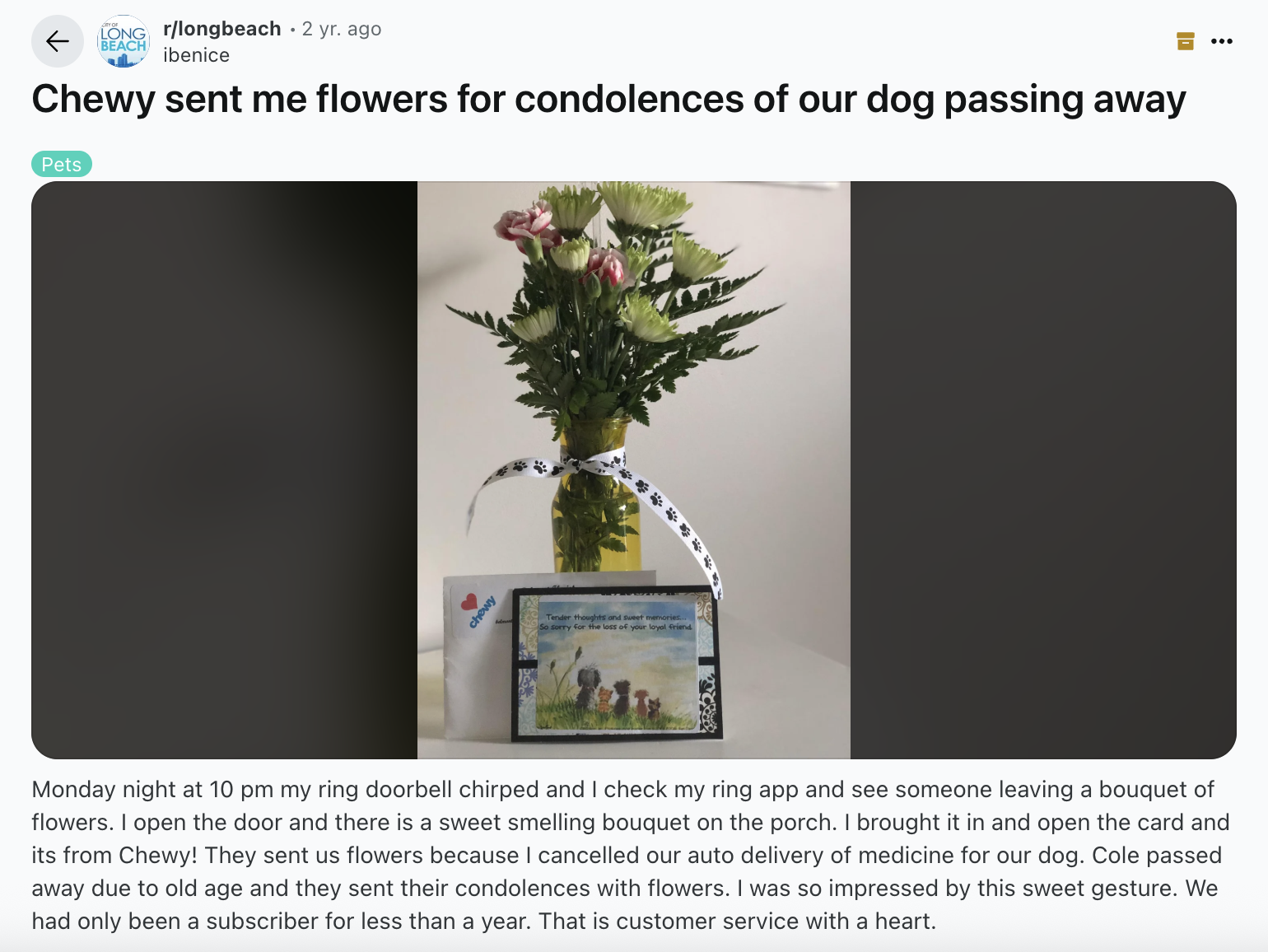
Actionable Tip:
Train your team to go beyond scripts. Encourage genuine empathy, and empower staff with the tools and authority to turn negative moments into memorable ones. Your greatest chance to build loyalty often comes in your customer’s hardest moments—how you respond can turn pain into a positive, lasting connection.
3. Personalize When You Can
Nearly 60% of customers say personalized engagement influences their purchasing decisions. Personalization is about understanding each customer’s story, needs, and preferences—and reflecting that back in every interaction.
Examples:
- Coca-Cola, Starbucks, M&M’s: Personalizing their product with customer names and locations
- Spotify: “Year in Review” wraps up your activity as a unique, shareable story.
- VitaminLabs: Personalizes your vitamin selection through a custom quiz.
With AI, personalization is easier to scale than ever—but the more human and relevant you make it, the more engaging it will be.
Actionable Tip:
Go beyond just using a customer’s name. Reference their last purchase, reward milestones, note their birthday, or anticipate needs before they ask. Use quizzes and curated bundles to create offers that feel truly tailored.
4. Establish Habits & Reward Your Clients
Great brands make repeat purchases easy—and rewarding.
Subscriptions, purchase reminders, and loyalty programs nudge customers to return, while perks and surprises help cement lasting habits. These mechanics facilitate decision-making by removing friction, making transactions as effortless as possible.
But remember: you’re not loyal to Amazon Prime or Netflix just because of the subscription mechanics—you’re loyal because of the underlying brand and service. The mechanics simply make it easier to keep coming back.
Examples:
- Wegmans: Sometimes pays for a customer’s groceries at random—a delightful surprise that builds goodwill and word-of-mouth.
- Starbucks: Its app tailors offers, collects rewards, and keeps you coming back for your next coffee.
- TikTok Lite Rewards: Attempted to drive daily engagement with login incentives. However, the program was permanently ended in the EU for Digital Services Act compliance.
Actionable Tip:
Identify the actions you want your clients to take and reward them meaningfully. Design loyalty programs that are genuinely valuable and effortless to use. Add “surprise and delight” moments to keep your brand top-of-mind and strengthen emotional connections.
Personalize your approach: if a customer always buys the same product, offer them a relevant complementary item to try, maybe with a handwritten note. These personal touches not only foster loyalty but also encourage customers to explore more of your offerings—maximizing both satisfaction and retention.
5. Ensure Quality—Consistently
Trust is the bedrock of loyalty. If you break it, customers rarely come back.
Consistency in quality—and a willingness to make things right when something goes wrong—are non-negotiable.
Examples:
- Toyota: Sets the gold standard for quality consistency. Their reputation for reliability comes from strict quality control across all factories. No matter where you go, you’ll see Toyotas on the road. Why? Because they’re known to be reliable in all conditions, with easy access to parts and service, and they remain affordable.
- Volkswagen: In 2015, they were caught cheating on emissions tests—a massive breach of trust. It wasn’t just a product defect; it broke customer confidence, and global brand loyalty plummeted. Between legal fines and lost trust, the estimated financial cost soared above $33 billion.
Actionable Tip:
Monitor feedback and returns closely—use surveys, interviews, and social listening. Have a clear, no-hassle process for resolving issues. Track your brand using one of the four main brand tracking methods. Make “quality control” a company-wide responsibility, not just a single department’s job. Regularly review and update your standards to ensure you’re always delivering what your customers expect.
6. Know Your Audience Like No One Else
The best brands truly understand their customers—who they are, what they value, and why they choose you. When you know your audience deeply, you can create high-performing campaigns, authentic messaging, and unwavering loyalty.
Example:
Take this famous New Balance campaign. It speaks directly to their core audience. Because they understand what matters to their customers, they nail the tone and authenticity. The result? Messaging that feels unmistakably New Balance—and impossible for competitors to copy.
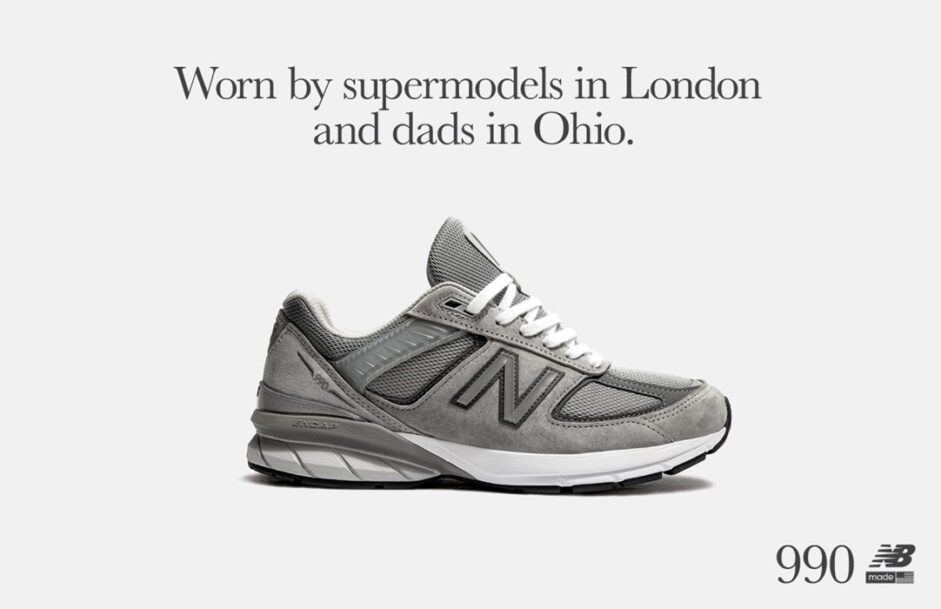
Actionable Tip:
Get to know your audience beyond the superficial persona. Combine methods for the clearest picture:
- Social Listening: Monitor social media, forums, and reviews for recurring themes, emotions, and unmet needs.
- Customer Interviews: Talk directly to your customers to uncover motivations, frustrations, and values.
- Targeted Surveys: Gather focused feedback on preferences, satisfaction, and brand perception.
- Brand Tracking: See how people really view your brand and competitors (including brand loyalty), and what you can do to stand out.
7. Involve Customers / Community
Loyalty deepens when customers feel part of the journey.
When brands invite customers to co-create—whether that’s voting on new products, giving feedback, or joining community events—it builds a true sense of ownership and belonging. While you can’t always involve customers directly in your product’s creation, you can still foster belonging through your brand personality, community-building, or engaging events.
Example:
Overnight Oats lets subscribers vote on the next flavor, turning them into direct contributors to the product lineup. This involvement transforms customers into invested partners, not just passive buyers. Not only does it involve the customer, but it also gives precious feedback for the product and marketing team.
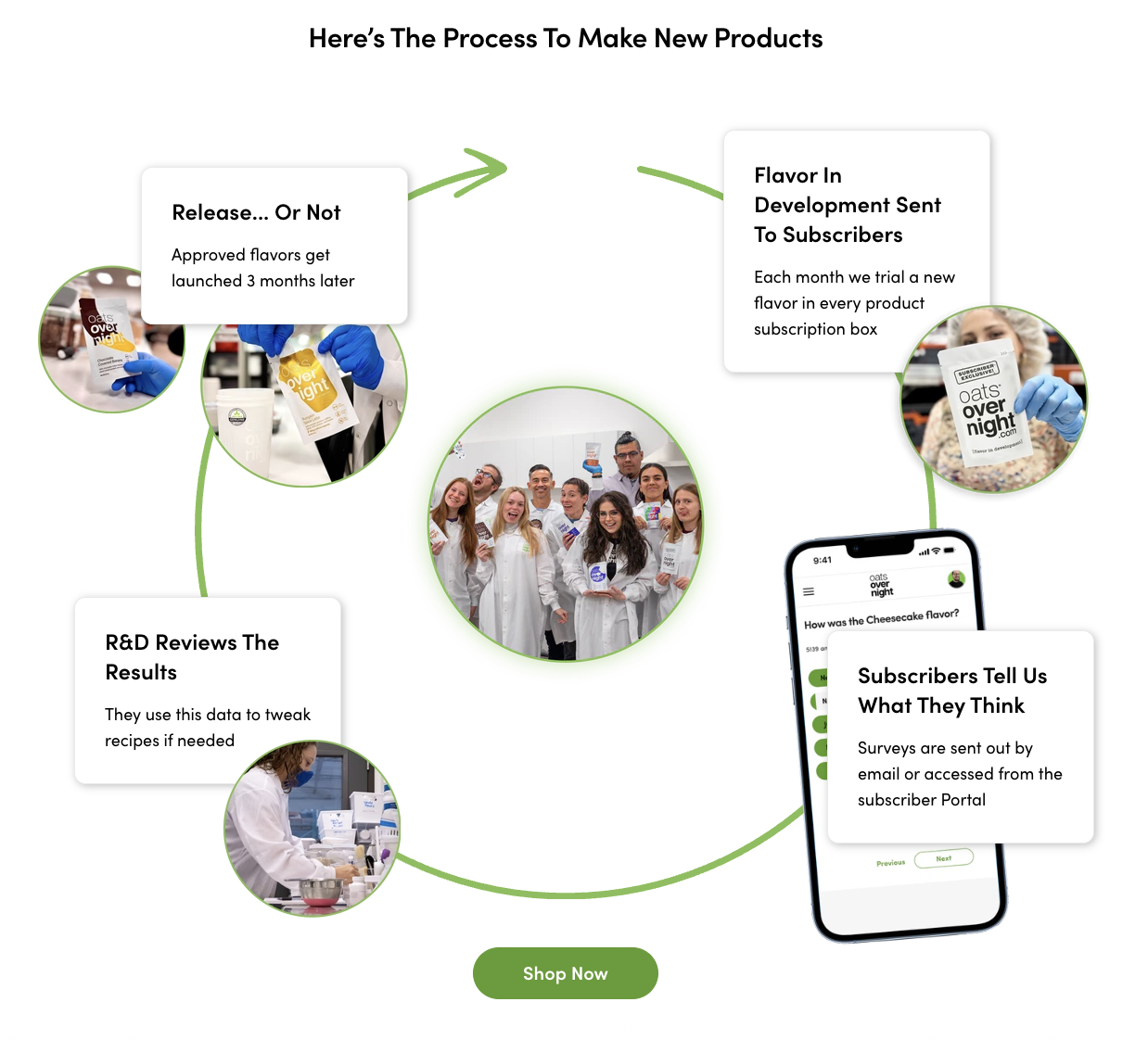
Actionable Tip:
Open the door for collaboration—run polls, design contests, feedback groups, or community events. Make it easy for customers to share ideas and actually see the impact. The more your audience helps build your brand, the more connected they’ll feel—and the more likely they are to stick around.
And don’t stop at product ideas: keep a real-time pulse on your community by listening to reviews and social mentions (more on this in the next section).
Brand loyalty isn’t built by checking a box or running a single campaign. It’s the sum of every touchpoint, every interaction, every day. The strongest brands win loyalty by making people feel valued, understood, and included—consistently.
Don’t try to do everything at once. Start with one area, do it exceptionally well, and build from there. Over time, your efforts will compound—turning customers into advocates and your brand into a habit they can’t live without.
How to Measure Brand Loyalty
Measuring brand loyalty is key to understanding your brand’s health. Knowing where you stand lets you fix what’s broken or double down on what works—directly impacting your bottom line. For example, improving retention usually pays off more than chasing new customers.
But with so many ways to measure loyalty, it can get confusing. To make it simple, we’ve grouped the most practical approaches into four key methods—industry best practices that every brand should track.
Check out the table below for common metrics you can start using right away.
1. Track Your Brand Performances
These are your bread-and-butter numbers: revenue per customer, purchase frequency, average basket size, retention rate, and churn rate.
You don’t need fancy tools—just dive into your business data. If you notice an abnormal or declining metric, address it immediately. These numbers are the heartbeat of your business and directly reflect the health of your brand loyalty.
2. Monitor What People Say About You
Customer sentiment is shaped in public. Reviews, testimonials, social media chatter, and forum discussions all add up to your brand’s reputation.
Airlines constantly monitor social channels—because a single viral complaint can change everything.
Remember United Breaks Guitars? It was a viral series of music videos created after United Airlines damaged a musician’s guitar and refused to compensate him. The result? According to Inc.com, 1.8 billion media impressions, millions of YouTube views, and instant brand damage.
But for others like Taylor Guitars—the manufacturer of Carroll’s broken guitar—this was an opportunity. By responding quickly and positively (donating two new guitars and making their own YouTube video about instrument care), Taylor Guitars turned a negative moment into a brand win. Their empathy was widely praised and actually boosted their brand image.
Actionable Tip:
Track your brand using social listening tools or set up Google Alerts for your name. Respond to feedback (positive and negative), and turn rising conversations into opportunities to delight customers and strengthen loyalty.
3. Ask Customers What They Think
Sometimes the best way to know how loyal your customers are is simply to ask.
Surveys and interviews give you direct, actionable insight into the “why” behind customer decisions.
Metrics like Customer Satisfaction Score (CSAT) and Net Promoter Score (NPS) are industry standards for a reason—they quantify loyalty and give you a benchmark. But don’t stop there: post-purchase surveys uncover what customers loved (or didn’t), and open-ended questions can reveal insights that can’t be found online.
Actionable Tip:
Run regular surveys and interviews, and don’t be afraid to ask big questions:
- Why did you choose us?
- Why did you leave?
- What would make you come back?
With Standard Insights brand tracking you can ask active category buyers about 20+ metrics—including loyalty—so you always know what’s moving the needle.
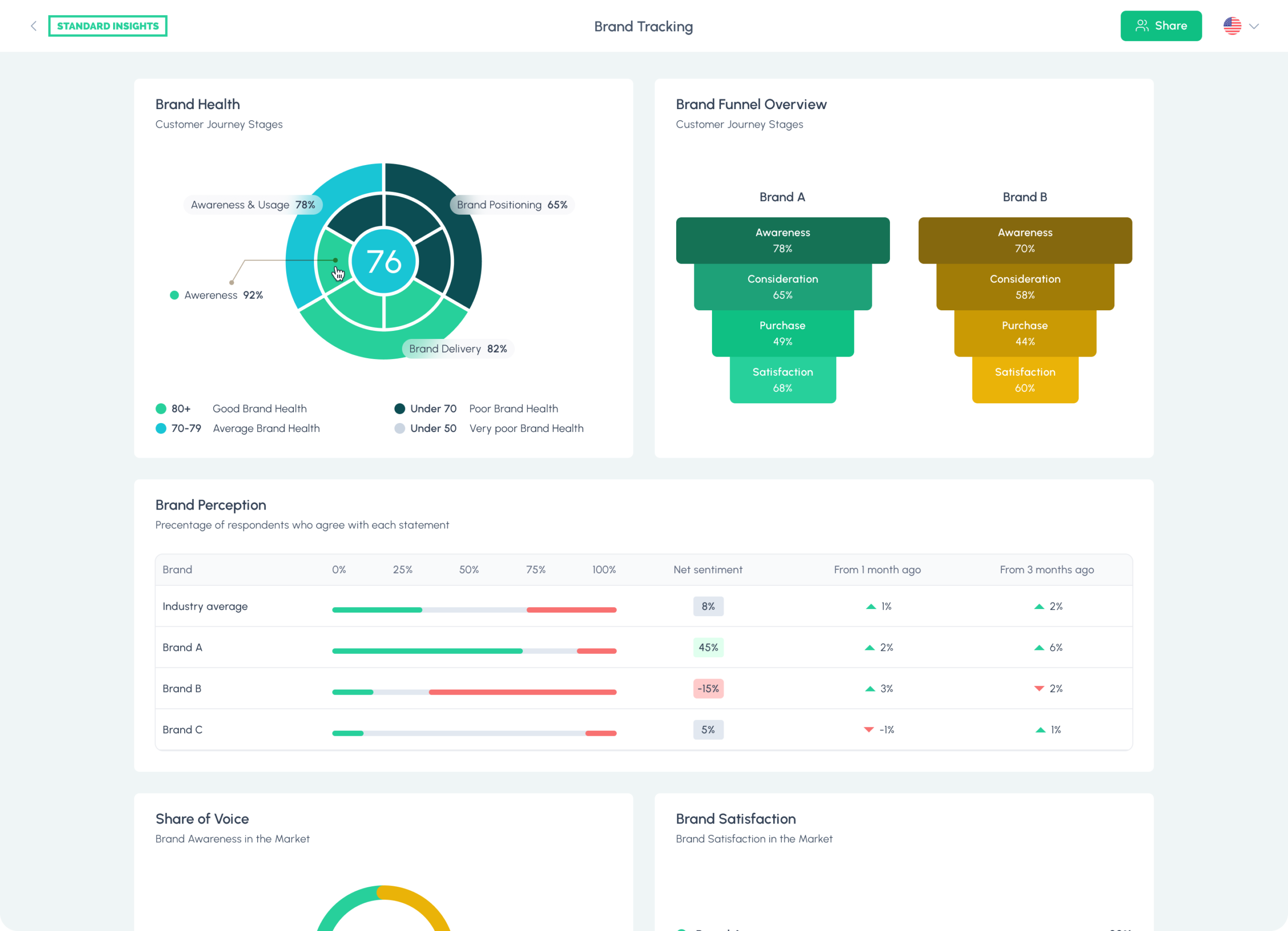
4. Analyze Customer Behavior
Actions speak louder than words.
Look for behavioral signals that reveal true loyalty:
- Referral Rate: Are customers actively recommending you?
- Engagement Metrics: How often do they interact, spend, or participate in your community?
- Share of Wallet: Are loyal customers spending more with you than with competitors?
These behaviors show not just what customers say, but what they do—and that’s the strongest indicator of loyalty.
Actionable Tip:
Set up dashboards to track key behaviors like referrals, engagement, and share of wallet over time. Don’t just collect the data—look for trends and patterns, and experiment with loyalty initiatives to see what actually moves these numbers.
12 Brand Loyalty Metrics
| Metric | What It Measures | Why It’s Useful | Recommended Score / Benchmark | How to Calculate |
|---|---|---|---|---|
| Repeat Purchase Rate (RPR) | How often customers buy again from you | Direct evidence of loyalty and satisfaction | 20–40% or higher (varies by industry) | (Number of customers who purchased more than once / Total customers) × 100 |
| Net Promoter Score (NPS) | Willingness to recommend your brand | Simple, widely benchmarked indicator of advocacy and loyalty | 30+ is good, 50+ is excellent | % Promoters (score 9–10) – % Detractors (score 0–6) (from NPS survey: “How likely to recommend?”) |
| Customer Lifetime Value (CLV) | Total revenue per customer over their relationship | Measures the long-term value of loyal customers | Aim to increase over time | Average purchase value × Purchase frequency × Customer lifespan |
| Retention Rate | % of customers who stay over time | Indicates satisfaction, loyalty, and value | 80%+ is strong (varies by sector) | ([Customers at end of period – New customers] / Customers at start) × 100 |
| Churn Rate | % of customers lost in a period | Inverse of loyalty—shows attrition | As low as possible (below 5–7% for SaaS) | (Customers lost during period / Customers at start) × 100 |
| Engagement Metrics | Interactions (visits, clicks, opens, comments, etc.) | Shows depth of brand relationship, not just transactions | Aim for steady growth | Track frequency/recency of engagement per customer (e.g., logins per month, email open rates, etc.) |
| Share of Wallet | % of customer’s spending with you vs. competitors | Shows if you’re their first choice | Higher than competitors | (Customer spend with your brand / Total spend in your category) × 100 |
| Referral Rate | % of customers who refer others | Indicates advocacy and word-of-mouth power | 20%+ is strong (varies) | (Number of referrals / Total customers) × 100 |
| Customer Reviews & Ratings | Satisfaction & sentiment (qualitative and quantitative) | Signals loyalty, advocacy, and areas to improve | 4.0+ out of 5 is strong | Average star rating, number of reviews, sentiment analysis |
| Customer Satisfaction Score (CSAT) | Overall satisfaction with a product/service | Gauges immediate emotional response | 80%+ is strong | (Number of satisfied responses / Total responses) × 100 |
| Customer Effort Score (CES) | How easy it is for customers to interact with you | Low effort = higher loyalty | 70+ (on 0–100 scale) | Average of responses to “How easy was it to…?” (1–5 or 1–7 scale, then normalized to 100) |
| Brand Advocacy Rate | % of customers who actively promote your brand | Measures organic, unpaid promotion | — | (Number of active advocates / Total customers) × 100 |
Notes
- Recommended scores are industry-dependent; always compare to your direct competitors and sector benchmarks.
- Not every business will use every metric, but combining several gives a much clearer, actionable picture of loyalty.
Don’t rely on a single metric or method.
The best brands combine operational data, public sentiment, direct feedback, and real customer behavior for a 360-degree view of brand loyalty. Beware of vanity metrics—focus on building genuine, long-lasting relationships, not just impressive loyalty reports. When you truly understand what’s working (and what’s not), you can adapt faster and grow stronger.
The Short of It
Brand loyalty isn’t built overnight, but it’s worth every effort and investment. To foster genuine loyalty, you need to define a clear brand personality and consistently exceed customer expectations—delighting and surprising them at every turn.
Challenges are inevitable, but how you respond in your customers’ toughest moments is when your brand’s true value shines through. The savviest brands actively seek out these moments to prove their worth and reinforce trust.
Staying close to your customers—truly understanding what they think, feel, and want—is essential. That’s why tracking your brand’s perception and loyalty is a game-changer.
There are many ways to measure your brand, from performance metrics to deeper insights about customer thoughts, words, and behaviors. If you want essential consumer insights, explore our comprehensive brand tracking solution, which includes loyalty and 20+ other vital marketing metrics.
Loyalty is a two-way street. If you are committed to your customers, they’ll return that loyalty—and your brand will flourish as a result.


